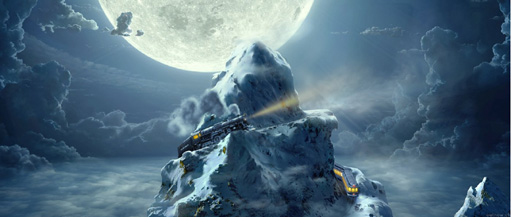Book vs. Movie: The Polar Express
By Kim Hollis
November 9, 2004
BoxOfficeProphets.com

And so, whenever the Tinsel Town hotshots decide that it's a great idea to turn the little-known Herman Melville classic Redburn into a theatrical event film, we'll be there. Whether the results are triumphant (see: The Lord of the Rings trilogy) or tragic (i.e. The Scarlett Letter), we'll take it upon ourselves to give you the verdict and spark the discussion.
After a brief reprieve from movie-based books, such theatrical adaptations are back in full force for the months of November and December. Look for this space to be chock-full from now until the end of the year.
The Polar Express
In 1985, children's author/illustrator Chris Van Allsburg's exquisite picture book The Polar Express started on its journey to becoming a timeless, well-loved Christmas classic. Now, director Robert Zemeckis attempts to bring that treasured story to life via a revolutionary new animation technique he calls "performance capture".
The Book
Van Allsburg's illustrated children's book is elegant in its simplicity. One Christmas Eve, a young boy looks out his window to discover an enormous train awaiting him. Once he boards, adventure awaits. The locomotive is headed straight for the North Pole, where those lucky enough to have been passengers on the Polar Express will have the opportunity to encounter Santa Claus himself.
The book comes to life thanks to Van Allsburg's gorgeous pictures that accompany the tale. The colors are bright and eye-catching, yet the illustrations have a soft edge that imparts a muted atmosphere of the imaginary and fantastical. It's a wonderful celebration of the holiday, giving special attention to the importance of faith and belief. If the ending is somewhat wistful, that only means it resonates as much for adults as it does for children.
The Movie
To move the straightforward story exemplified in the book to an extended tale appropriate for a theatrical feature, the basic elements of the plot were expanded. Though in the book it is implied that the hero boy might be having a crisis of faith, in the film it is explicitly stated. Hero Boy is suspicious about whether Santa really exists. As a result, he has begged off the task of leaving the cookies and milk for the jolly old elf, instead letting that joyous job fall to his younger sister. Even more importantly, though, he just can't hear the sleigh bells of Santa's sleigh. Most of his friends at school have convinced Hero Boy that Santa's existence is a myth; he's just looking for proof to back up their assertions. When he discovers that his encyclopedia defines the North Pole as a barren, cold place that is devoid of much life, Hero Boy figures he's got the story worked out.
That all changes, of course, when the Polar Express arrives on his front lawn. Once he boards, Hero Boy is in for an amazing adventure. On the train itself, he makes new friends, including a man who may or may not be a ghost of some sort, and encounters wondrous sights and events.
The story truly does come to life through the use of a novel form of animation. Director Zemeckis' performance capture technique utilizes the facial and body movements of real people to create the animated human characters that populate the film. It's not quite perfect - the faces of the people look more like videogame characters than the more cartoon-ish humans who exist in the worlds of stuff like Shrek and The Incredibles. As a result, the movement of the mouths in particular is somewhat jarring and difficult to reconcile.
On the other hand, the background animations are superb. The train has a life of its own, in fact, and even the snowflakes seem to sparkle. There's never a sense that you're watching something real, but that's okay. What the film does do nicely is evoke the same emotions that come when reading the book and contemplating the illustrations.
Along with the comfort that comes from seeing the book's pictures come alive on the big screen, there's also the constant presence of Tom Hanks. The decision to cast him in numerous roles - most notably, the conductor of the train - was masterful. Because he's so recognizable, there's something reassuring about hearing his boisterous laugh as the train manages to escape near disaster on an enormous patch of ice.
The Verdict
While the book is already a Caldecott Medal winner and a Christmas classic destined to be read and re-read by children of all ages, the movie is equally appealing. It's a warm, blissful Christmas celebration that obviously comes straight from the heart. The story is captivating and engaging for all ages, but even more importantly, the film feels as ageless as the book does. Both the book and the movie could have been as special to readers and audiences in the 1930s as they are today.
And perhaps my favorite thing about the translation of the book to the film is that both end with exactly the same resonant picture. It warms my heart to see it.